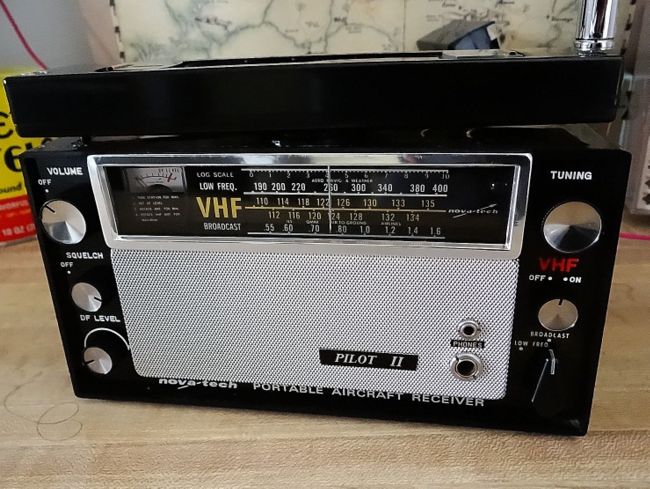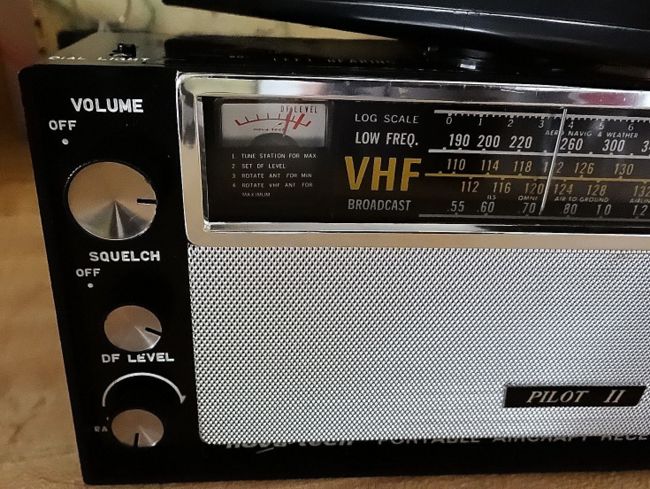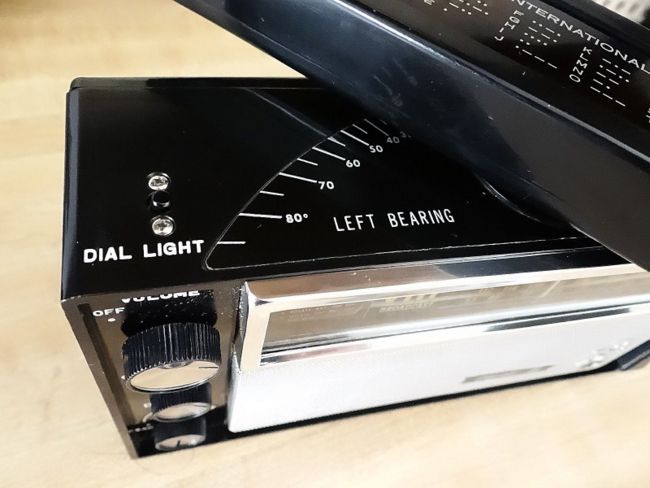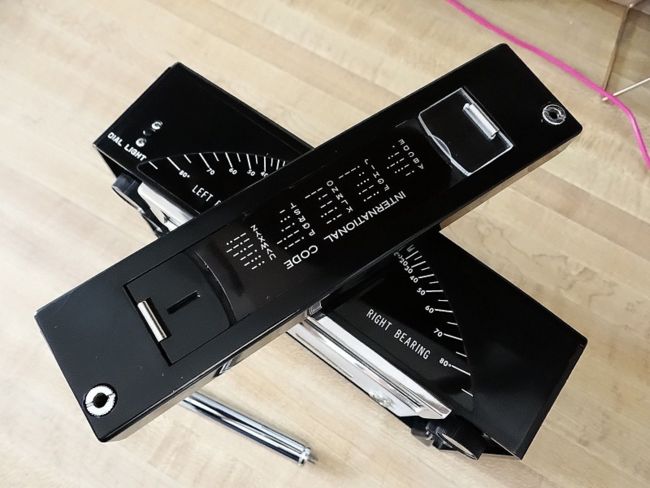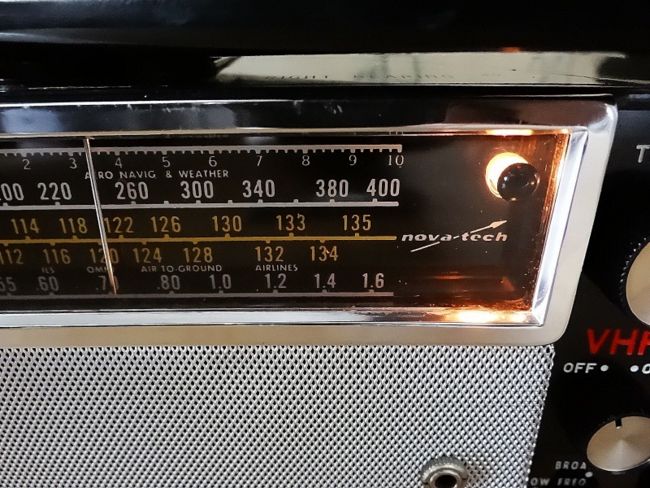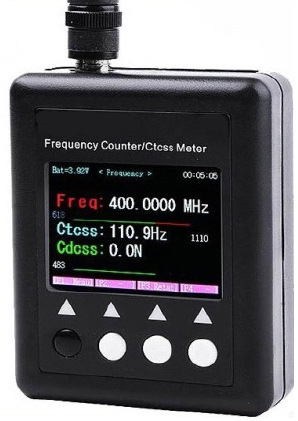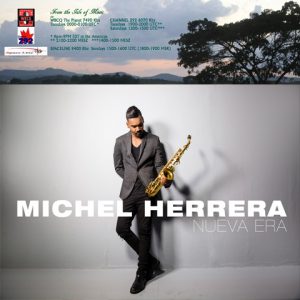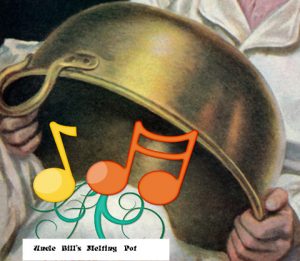Many thanks to SWLing Post contributor, Eric McFadden, for sharing the following announcement for International Marconi Day. Eric states, “I love the presentation of this invitation!” Me too, Eric!

Monthly Archives: April 2018
Guest Post: The Prof finds a Nova Tech Pilot II RDF receiver
Many thanks to SWLing Post contributor, The Professor, who shares the following guest post:
A 1960s Signal Sniffer
by The Professor
I just recently purchased a radio that on eBay that looks very intriguing, especially if you happen to DX AM Radio. It’s a mid-60s portable made in Japan – a Nova Tech Pilot II . However, wasn’t just a grab ën go to the beach kind of transistor set. This radio has a serious side. It’s actually an RDF – a “radio direction finder.”
I have seen these kinds of radios before, somewhere. Only the ones I’ve noticed were older and had more of a military look. Although I’ve never actually attended a hamfest, I’m sure these types of receivers might be found at a gathering like that.
But this is a smaller and frankly more stylish version of RDF. Not to go into too much detail about something I know little about, but before GPS became ubiquitous, devices like this would commonly assist in the navigation of ships and aircraft by pinpointing “beacon” transmitters at specific known locations.
As you might imagine, this type of technology was (and probably still is) a strategic tool for military purposes. In fact, one of more “infamous” incidents of using radio direction finders was when they were utilized by the Japanese in the bombing of Pearl Harbor. Their bombers just honed in on the signal of a Honolulu AM station (KGU at 760kHz) as their beacon.
So, this radio has three bands which were traditionally used by beacon transmitters. Besides the medium wave band, it also has a section of the longwave spectrum, and the VHF airband. Other models included the old marine band (around 3 to 5MHz). A later model also included the CB frequencies, and another included a VHF police band (called the Nova Tech Action!!).
So, no shortwave on this one. No FM either, but I have plenty of radios with those bands (like almost all of them). Of course, there’s not much to find on this side of the world on longwave these days, and listening to aircraft communications has its fans but it’s not something I’ve done much. But this thing has a unique toolset for medium wave DXing. And after doing a little research online I’ve discovered that the big rotating double ferrite on top is only one of the attributes it offers for AM DXing purposes.
For one, it has an RF amplifier in the front end to help pull those weak signals up out of the noise floor. For another, it has a pure RF gain function called “DF” (direction finder), which when turned on shuts down the AGC (automatic gain control) and allows you to tweak the RF gain any way you like. And it also has a very accurate tuning meter. That all sounds good to me.
So, I haven’t actually seen my Nova Tech in the flesh yet, and it will be probably a couple of weeks before I get a chance to give it a test drive. But I’m pretty confident in my purchase at this point. More than a few people have spoken glowingly of the AM DXing capabilities of this set. But one of the reasons I decided to go ahead and bid on this device was that not only did the dealer have an excellent eBay rating, but he says he also fully serviced the radio electronically and physically restored most of its original beauty. Apparently, it was cleaned up, recapped, and even a transistor was replaced. And he also aligned the AM band IF and re-peaked the antenna trim for AM and the airband.
Although this radio is still a twinkle in my eye at this point, I thought I’d mention it here in hopes some of the fine readers of this blog might have something to say about DXing with direction finding radios. And I was especially hoping that a few people might have personal experience with these 60s era Nova Tech receivers. I also noticed online that there are U.K. versions of these RDFs that were branded as “Bendix” radios.
All insights offered as comments are appreciated, and once I spend some time with this radio I’ll be sure to offer some of my own.
I always find it so much fun to await the arrival of an interesting old radio I’ve purchased on eBay, especially one that I’d never heard of before.
Thanks for sharing your find, Professor! I was not at all familiar with the Nova Tech Pilot II. I love the Transoceanicesque design! No doubt, it’ll be a handsome addition to your collection, and I’m willing to bet a MW DX machine as well!
An example of astronomical third party pricing on Amazon.com
I’ve been helping a friend’s daughter study for her Technician Amateur Radio License. Besides my tutoring, she’s only been studying with a free phone app thus far and essentially learning the answers to the questions. I know she really needs a book that can provide context for each question.
Since there was no need to buy a new $30 guide (that’s only valid until the end of June), I started my search on Amazon.com thinking that there may be some affordable, good condition used study guides I could snag for a decent price.
I was wrong.
Check out the screenshot below from this page:

 And if $2,000 US (plus $3.95 shipping!) wasn’t too high…
And if $2,000 US (plus $3.95 shipping!) wasn’t too high… $4,093 (plus $3.95 shipping!) for a used “Acceptable” condition Technician License Study Guide?!? What a deal! Is there a limit on how many I can buy? 🙂
$4,093 (plus $3.95 shipping!) for a used “Acceptable” condition Technician License Study Guide?!? What a deal! Is there a limit on how many I can buy? 🙂
I’ve heard that some sellers add high prices to items that they want to put on “hold.” I did some searching this afternoon and saw discussions by sellers admitting that this technique saves them time from relisting an item that might need more research. More than one admitted that “And hey, if someone buys it for that price, all the better!”
Personally, I think this practice should be banned by Amazon. I checked out one of the stores from a seller in the list above and almost all of their listings have astronomical prices.
What do you think? Am I the only one noticing this trend?
Guest Post: Review of the TYT SF-401 Plus Frequency Counter/Tone Meter
Many thanks to SWLing Post contributor, Mario Filippi (N2HUN), for sharing the following guest post:
TYT Frequency Counter/Tone Meter Review
by Mario Filippi (N2HUN)
All photos courtesy of author
Most hobbyists own some type of transceiver whether it is a handheld, mobile, or base station. Some examples are amateur radio HF/VHF/UHF transceivers, Citizen’s Band radios, FRS (Family Radio Service) and GMRS (General Mobile Radio Service) handhelds.
A useful tool for the shack or the field is a frequency counter/tone meter since it can measure frequencies and analog/digital tones from transmitters/transceivers. At times ascertaining that a UUT (Unit Under Test) such as a 2 meter handheld is transmitting accurately may be indicated due to problems communicating with other stations. In addition, if the UUT transmits a sub-audible tone (either analog or digital) to access a repeater, a frequency counter/tone meter can detect the presence and verify accuracy of the CTCSS/digital tone.

Author’s TYT SF-401Plus, includes instructions, antenna, rechargeable battery and charger/cable. Covers 27 MHz – 3 GHz
Frequency/tone meters can be purchased for less than twenty US dollars but normally do not include a rechargeable battery and BNC connector for attaching an external antenna. Having had experience with these types, the time finally came for an upgrade.
After shopping around a decision was made to purchase the Tytera TYT SF-401 Plus. This model includes an instruction sheet, antenna, internal rechargeable battery, USB charger and cable. It represents a significant improvement over my previous, inexpensive meter, as the TYT has a BNC connector to attach a larger antenna and has four control buttons on the front panel. It also has, via a system menu, options to adjust the frequency/tone offset, dimmer levels, three or four decimal display and auto power off. All these valuable features warrant a higher cost, which was about $50, but well worth it. This price fits the budget of most hobbyists. However, higher end frequency/tone meters are available and cost several hundred dollars for those requiring that level of quality.
Out of the box the TYT SF-401 Plus, when checked against an IFR FM/AM-500A communications service monitor, was right on the money as far as accuracy. Note that the IFR-500A was calibrated against a high precision internal 10 MHz crystal in an “oven” and this is my gold standard reference for frequency accuracy in my shack.

TYT accuracy checked against an IFR FM/AM-500A communications service monitor transmitting a 146.52 MHz/131.8 Hz tone. Note frequency readout to four decimal places.
Now, it was time to check typical radios around the shack using the TYT. The first radio tested for frequency accuracy was a BTECH GMRS-V1 HT which I use to communicate with the home QTH while running errands around town. See photo for results. The BTECH and TYT agreed perfectly. Note that the TYT’s display includes a battery status indicator on top left and a timer use indicator, which resets every time the TYT is turned on. If you are going to measure digital signals (not included in this review) there is an option in the Setup Menu for that. With the BTECH handheld running 2 watts the TYT could detect its’ frequency at roughly four feet away.

Confirming BTECH transmit frequency against the TYT. Output is 2 watts. TYT multicolor display is super.
For VHF/UHF operating, especially when afield with other hams or groups such as CERT (Community Emergency Response Teams), problems can ensue if one does not have the correct frequency or tone programmed, so having the TYT in your shirt pocket to confirm these parameters when trouble occurs can be a quick way to get to the problem. See photo of an Icom IC-2300H 2 meter transceiver checked against the TYT for proper offset and tone. The Icom was putting out 65 watts and a repeater with an offset of -1.3 MHz and 88.5 Hz tone was checked.

TYT confirming unusual offset (-1.3 MHz) and tone for a repeater. Icom IC-2300H was at high (65W) setting and connected to an outdoor discone antenna.
According to the instructions included with the TYT SF-401 Plus, the operating range is from 27 MHz – 3000 MHz with a note stating “27 MHz – 100 MHz it can not be guaranteed and the corresponding normal emission appliance” which I interpret as accuracy is not guaranteed in this frequency range. Well, I checked the TYT against the IFR FM/AM-500A service monitor transmitting an AM signal on CB Channel 19, 27.185 MHz, and the TYT measured it exactly. One other important note is that according to the instructions, the tone decoder operates in the 136 MHz – 174 MHz and 400 MHz – 520 MHz frequency range. So that may limit its use in certain areas of the spectrum. One other item if interest is that the TYT has a 10 dB attenuator when dealing with high power signals.
All in all, I’m very happy with this purchase, and find the TYT SF-401 Plus useful for “first pass” troubleshooting and helpful when aligning older rigs which due to age are off frequency /tone. It definitely has a use in this shack.
Wow–what a bargain tool for the radio shack! Thank you for sharing your review, Mario. Once again, however, you have tempted me with a purchase! I remember when frequency counters would set you back a couple hundred bucks–it’s insane to think that you can grab one for $40-50 US shipped.
SF-401 Plus Retailers:
Note that the TYT SF 401 Plus is also marketed as the Surecom SF401 Plus:
Special two hour DRM broadcast today at 12:00 UTC
According to the DRM Consortium, there will be a special two hour DRM broadcast today (April 18) starting at 12:00 UTC:
Special DRM transmission tomorrow 18th April from Spaceline during DRM GA at 1200-1400UTC on 11600kHz. From Kostinbrod, Bulgaria with antenna directed at 260 degrees. The content will be from Mighty KBC.
Note that this broadcast starts less than two hours from time of posting. Please comment if you log this broadcast!
RootIO and a new community radio initiative in Uganda
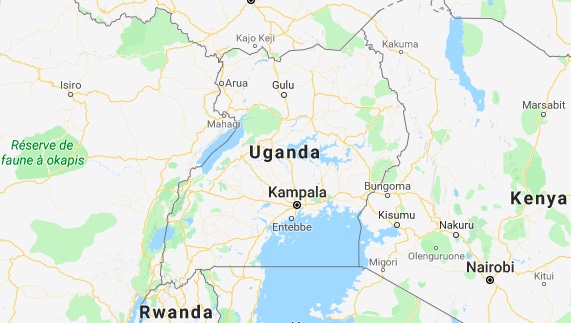
(Source: Global Voices via Mike Hansgen)
How RootIO Broadcasts Radio in Uganda Using a Bucket
The open-source toolkit allows users to broadcast using just a smartphone and a transmitter
Radio is still and continues to be a powerful medium across most of the African continent. Not only is radio used to share community information but it is cheap and very accessible. In Uganda, a mixing of radio’s power with new mobile and internet technologies has created a cheap and powerful open-source toolkit that allows communities to create their own micro-radio stations. All one needs is an inexpensive smartphone and a transmitter and a community that will share, promote and collaborate on dynamic content.
[…]They have no studio and all the radio shows are done using the host’s smartphone.
How does this work? Users can purchase most of the materials at local markets. A small transmitter is built into a waterproof bucket with a fan, a charge-controller and a smartphone, which is connected to an antenna and a solar panel.
The radio stations are really small and can serve a village or a couple of villages reaching to 10,000 listeners. The content produced by the radio hosts lives in the cloud so stations are able to share content with other stations.[…]
Click here to read the full article at Global Voices.
Note that we first published a post about RootIO five years ago. Very happy to see it’s now in use!
FTIOM & UBMP, April 22-28
From the Isle of Music, April 22-28:
Our celebration of Jazz Appreciation Month continues with special guest Michel Herrera, an important young saxophonist/composer/bandleader/producer, who will converse with us about his newest recording and the newest generation of Jazz musicians in Cuba. We will also listen to some of his excellent music.
Four opportunities to listen on shortwave:
1. For Eastern Europe but audible well beyond the target area in most of the Eastern Hemisphere (including parts of East Asia and Oceania) with 100Kw, Sunday 1500-1600 UTC on SpaceLine, 9400 KHz, from Kostinbrod, Bulgaria (1800-1900 MSK)
2. For the Americas and parts of Europe, Tuesday 0000-0100 UTC on WBCQ, 7490 KHz from Monticello, ME, USA (Monday 8-9PM EST in the US). This has been audible in parts of NW, Central and Southern Europe with an excellent skip to Italy recently.
3 & 4. For Europe and sometimes beyond, Tuesday 1900-2000 UTC and Saturday 1200-1300 UTC on Channel 292, 6070 KHz from Rohrbach, Germany. In recent weeks, the Tuesday night transmission has been heard well in the UK and in Western Russia along with a VERY long skip to parts of New Zealand….
Uncle Bill’s Melting Pot, Sunday, April 22, 2018:
We are fond of telling people that UBMP covers Afghanistan to Zimbabwe, and Episode 59 proves it – we’re off to Afghanistan!
Afghanistan is a collage of several ethnic groups, and some of the music may surprise you.
Sundays 2200-2230 UTC (6:00PM -6:30PM Eastern US) on
WBCQ The Planet 7490 KHz shortwave from the US to the Americas and parts of Europe
In recent weeks the signal has had a nice bounce to Spain, Italy and Switzerland as well as Iceland, Ireland and parts of the UK. Also audible in Brasil, Paraguay and points North.
Starting May 1, UBMP will be adding a Tuesday night transmission on Channel 292, 6070 Khz from 2000-2030 UTC.

